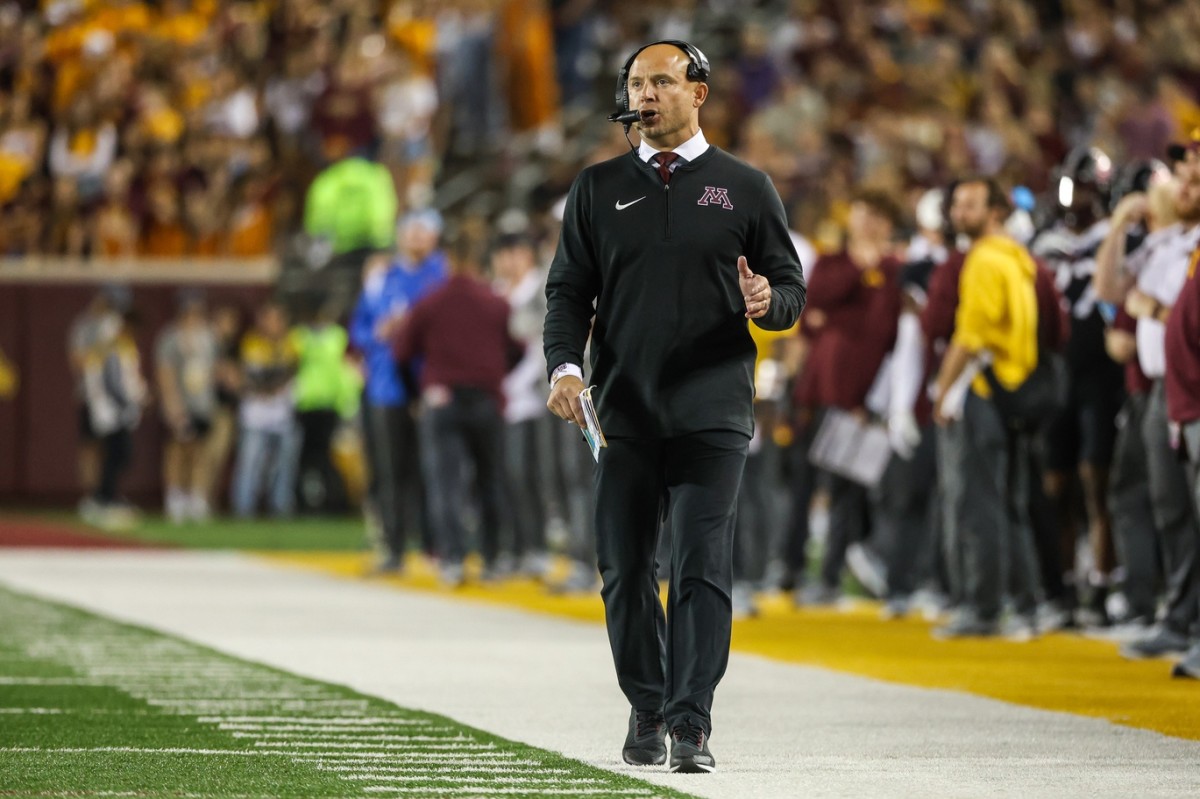P.J. Fleck has to adapt or die in new college football world

The Minnesota Golden Gophers wrapped up a disappointing regular season on Saturday afternoon with a loss to the Wisconsin Badgers. The defeat dropped Minnesota to 5-7 and while they will go to a bowl game, head coach P.J. Fleck has already defined 2023 as a "readjustment year."
"I've kind of named it the readjustment year," Fleck said Saturday. "There's a lot of things to adjust moving forward. There's a lot of things to evaluate but there are a lot of things outside of our control."
While Fleck is correct, there are also some things that he and the program can control. The landscape of college football is different than the one that Fleck knew when he took over at Minnesota in 2017, and Fleck must quickly realize that he needs to adapt or die in the new college football world.
Minnesota reached its peak in 2019 when Tanner Morgan, Rashod Bateman and Tyler Johnson formed a passing attack that produced a school record 30 passing touchdowns, but Minnesota hasn't been able to come close to recreating that magic as Morgan regressed and Athan Kaliakmanis struggled mightily in his first full season as the starting quarterback.
Kaliakmanis, Viotto entering portal: Who will be Gophers QB in 2024?
A potent passing attack is a necessity in this era of college football as most of the top teams have an elite quarterback or a dynamic aerial attack. In fact, seven of the top 10 quarterbacks in passing yards this season have their team ranked in the top 25 of the latest College Football Playoff Rankings while Kaliakmanis is ranked 86th in the FBS with 1,838 passing yards. As a team, the Gophers rank 123rd nationally in passing yards per game at 153.2, nowhere near the 300+ passing yards juggernauts like Oregon, Washington and Georgia pile up on a weekly basis.
"I think we'll look at the schematic piece," Fleck said about the passing offense after losing Paul Bunyan's Axe to Wisconsin. "But it doesn't matter if you don't execute it. Every play doesn't look good if we don't catch it, right? If we don't throw it to the open guy. If we fumble the football...if we drop the ball. ...We have to execute. It's more of the execution that has to be better than anything and I think that's very clear to see."
Even if the Gophers find a higher level of execution, it won't fix the 461 rushing attempts that Fleck's offense ran this season. Or the fourth-down punts in opponent territory despite having the highest conversion rate in the country at 81 percent. The fix is a dangerous passing game.
Fleck can blame injuries and depth all he wants, but scheme is the No. 1 killer.
"At one point there were five...six freshmen on that defense on the field at one time today," Fleck said Saturday. "That's not where you want to be and there's a lot of reasons for that. And none of you really care about those reasons. ...But I know the reasons and it's my job to get that better and that's exactly what they're going to do."
Fleck must also navigate the new college football world where Name, Image and Likeness (NIL) money is king. Will he be able to recruit players who are good enough to run a pass-heavy offense?

The Gophers have already been stung by NIL, losing several key players to the transfer portal. The biggest name to date is Mar'Keise Irving, who is now starring for the Oregon Ducks. And on Tuesday a handful of Gophers announced plans to transfer, including Kaliakmanis and third string freshman QB Drew Viotto.
"We had players that were here that are now gone, playing at another school that should be here playing right now. Because again, NIL. We didn't pay them. We didn't pay them enough," Fleck said in September.
While current conference rivals Michigan, Ohio State and Penn State are able to utilize their financial backers to bring in high-level talent, the Gophers are left in the cold as big companies and donors would seemingly rather invest in marquee talent. The recipe for NIL success seems to be that a program either recruits a 5-star player or lures a prized transfer. Minnesota has done neither.
What's more is that a player like Michigan quarterback J.J. McCarthy, a possible first-round pick in the 2024 NFL Draft, is essentially his own brand, carrying a following of 250,000 on Instagram compared to the 12,000 followers of a player like Kaliakmanis. Big money wants big reach, and that's what Minnesota doesn't have right now — even with a potential first-round pick like safety Tyler Nubin.
The competition for Minnesota is only going to stiffen when USC, UCLA, Oregon and Washington join the Big Ten next season. Understanding the situation, Fleck has taken a different approach, opting to recruit and develop rather than dive into college football's version of free agency.
But if Fleck and the coaching staff develops a prospects into star players, there is an immediate threat of other programs poaching said players with fat stacks of cash. It’s the exact situation Washington State is dealing with now as standout QB Cam Ward has reportedly received at least ten $1 million offers.
"If we want to keep players, all these guys we have, they won't be here next year," Fleck said earlier this year. "Just making sure everybody understands. Our fans, [the good players] won't be here. We'll be a Triple-A ballclub for somebody else. That is the reality and the truth of the situation."
Fleck and Minnesota are back against a wall and the only way they're going to begin moving forward is if the offensive style of play evolves to match the styles of the best programs in the country.
They. Must. Throw. The. Ball.
If they don't adapt, Fleck and the Gophers will die.
